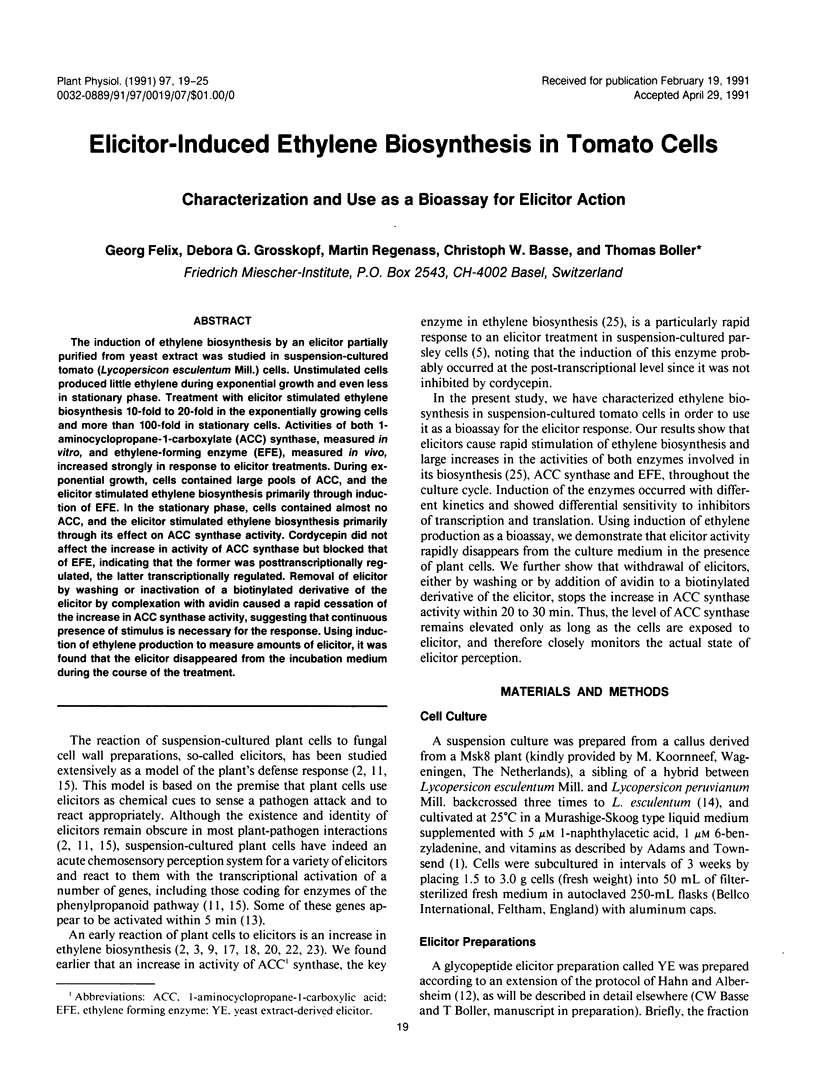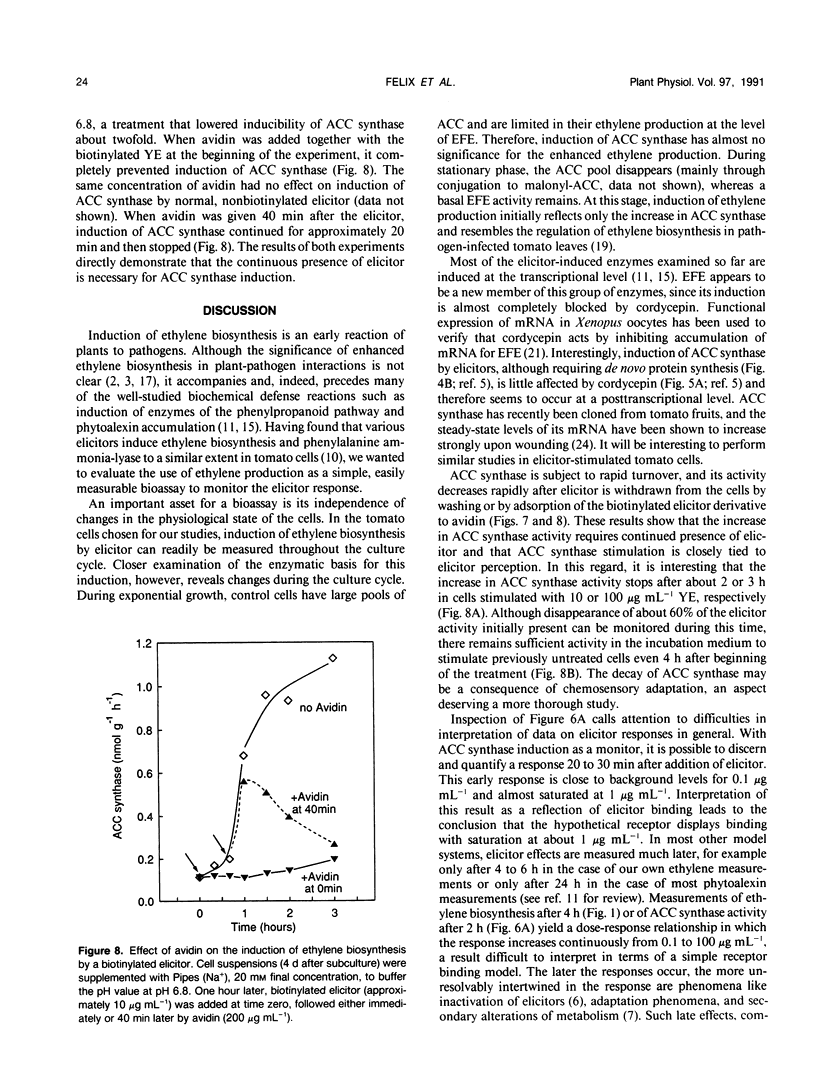Abstract
The induction of ethylene biosynthesis by an elicitor partially purified from yeast extract was studied in suspension-cultured tomato (Lycopersicon esculentum Mill.) cells. Unstimulated cells produced little ethylene during exponential growth and even less in stationary phase. Treatment with elicitor stimulated ethylene biosynthesis 10-fold to 20-fold in the exponentially growing cells and more than 100-fold in stationary cells. Activities of both 1-aminocyclopropane-1-carboxylate (ACC) synthase, measured in vitro, and ethylene-forming enzyme (EFE), measured in vivo, increased strongly in response to elicitor treatments. During exponential growth, cells contained large pools of ACC, and the elicitor stimulated ethylene biosynthesis primarily through induction of EFE. In the stationary phase, cells contained almost no ACC, and the elicitor stimulated ethylene biosynthesis primarily through its effect on ACC synthase activity. Cordycepin did not affect the increase in activity of ACC synthase but blocked that of EFE, indicating that the former was posttranscriptionally regulated, the latter transcriptionally regulated. Removal of elicitor by washing or inactivation of a biotinylated derivative of the elicitor by complexation with avidin caused a rapid cessation of the increase in ACC synthase activity, suggesting that continuous presence of stimulus is necessary for the response. Using induction of ethylene production to measure amounts of elicitor, it was found that the elicitor disappeared from the incubation medium during the course of the treatment.
Full text
PDF






Selected References
These references are in PubMed. This may not be the complete list of references from this article.
- Bradford M. M. A rapid and sensitive method for the quantitation of microgram quantities of protein utilizing the principle of protein-dye binding. Anal Biochem. 1976 May 7;72:248–254. doi: 10.1016/0003-2697(76)90527-3. [DOI] [PubMed] [Google Scholar]
- Cline K., Albersheim P. Host-Pathogen Interactions : XVII. HYDROLYSIS OF BIOLOGICALLY ACTIVE FUNGAL GLUCANS BY ENZYMES ISOLATED FROM SOYBEAN CELLS. Plant Physiol. 1981 Jul;68(1):221–228. doi: 10.1104/pp.68.1.221. [DOI] [PMC free article] [PubMed] [Google Scholar]
- Dixon R. A., Dey P. M., Lawton M. A., Lamb C. J. Phytoalexin Induction in French Bean : Intercellular Transmission of Elicitation in Cell Suspension Cultures and Hypocotyl Sections of Phaseolus vulgaris. Plant Physiol. 1983 Feb;71(2):251–256. doi: 10.1104/pp.71.2.251. [DOI] [PMC free article] [PubMed] [Google Scholar]
- Fuchs Y., Saxena A., Gamble H. R., Anderson J. D. Ethylene biosynthesis-inducing protein from cellulysin is an endoxylanase. Plant Physiol. 1989 Jan;89(1):138–143. doi: 10.1104/pp.89.1.138. [DOI] [PMC free article] [PubMed] [Google Scholar]
- Grosskopf D. G., Felix G., Boller T. K-252a inhibits the response of tomato cells to fungal elicitors in vivo and their microsomal protein kinase in vitro. FEBS Lett. 1990 Nov 26;275(1-2):177–180. doi: 10.1016/0014-5793(90)81466-2. [DOI] [PubMed] [Google Scholar]
- Hahn M. G., Albersheim P. Host-Pathogen Interactions: XIV. Isolation and Partial Characterization of an Elicitor from Yeast Extract. Plant Physiol. 1978 Jul;62(1):107–111. doi: 10.1104/pp.62.1.107. [DOI] [PMC free article] [PubMed] [Google Scholar]
- Hedrick S. A., Bell J. N., Boller T., Lamb C. J. Chitinase cDNA cloning and mRNA induction by fungal elicitor, wounding, and infection. Plant Physiol. 1988 Jan;86(1):182–186. doi: 10.1104/pp.86.1.182. [DOI] [PMC free article] [PubMed] [Google Scholar]
- Lizada M. C., Yang S. F. A simple and sensitive assay for 1-aminocyclopropane-1-carboxylic acid. Anal Biochem. 1979 Nov 15;100(1):140–145. doi: 10.1016/0003-2697(79)90123-4. [DOI] [PubMed] [Google Scholar]
- Mauch F., Hadwiger L. A., Boller T. Ethylene: Symptom, Not Signal for the Induction of Chitinase and beta-1,3-Glucanase in Pea Pods by Pathogens and Elicitors. Plant Physiol. 1984 Nov;76(3):607–611. doi: 10.1104/pp.76.3.607. [DOI] [PMC free article] [PubMed] [Google Scholar]
- Rickauer M., Fournier J., Esquerré-Tugayé M. T. Induction of Proteinase Inhibitors in Tobacco Cell Suspension Culture by Elicitors of Phytophthora parasitica var. nicotianae. Plant Physiol. 1989 Jul;90(3):1065–1070. doi: 10.1104/pp.90.3.1065. [DOI] [PMC free article] [PubMed] [Google Scholar]
- Spanu P., Felix G., Boller T. Inactivation of stress induced 1-aminocyclopropane carboxylate synthase in vivo differs from substrate-dependent inactivation in vitro. Plant Physiol. 1990 Aug;93(4):1482–1485. doi: 10.1104/pp.93.4.1482. [DOI] [PMC free article] [PubMed] [Google Scholar]
- Tong C. B., Labavitch J. M., Yang S. F. The induction of ethylene production from pear cell culture by cell wall fragments. Plant Physiol. 1986 Jul;81(3):929–930. doi: 10.1104/pp.81.3.929. [DOI] [PMC free article] [PubMed] [Google Scholar]
- Toppan A., Esquerré-Tugayé M. T. Cell Surfaces in Plant-Microorganism Interactions : IV. Fungal Glycopeptides Which Elicit the Synthesis of Ethylene in Plants. Plant Physiol. 1984 Aug;75(4):1133–1138. doi: 10.1104/pp.75.4.1133. [DOI] [PMC free article] [PubMed] [Google Scholar]
- Van der Straeten D., Van Wiemeersch L., Goodman H. M., Van Montagu M. Cloning and sequence of two different cDNAs encoding 1-aminocyclopropane-1-carboxylate synthase in tomato. Proc Natl Acad Sci U S A. 1990 Jun;87(12):4859–4863. doi: 10.1073/pnas.87.12.4859. [DOI] [PMC free article] [PubMed] [Google Scholar]


